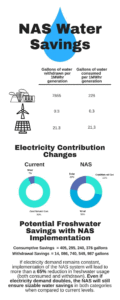
 Water demand from the power sector heightens competition for freshwater resources and thereby increases prices for many sectors of the economy. Therefore, it is crucial to examine any changes to water usage patterns which may be the result of NAS implementation. Changes to both withdrawal and consumption influence the stock of water available. The term “withdrawal” constitutes all freshwater removed from a water source, while “consumed” water is the total volume of water not returned to the original source after electricity has been generated (it is therefore not available for other withdrawals). Comparatively, fossil energy withdraws and consumes more water per MWhr than equivalent renewable generation. Therefore, much of the water savings achieved by the NAS are the result of increased renewable penetration in the electric grid. When determining withdrawal and consumption changes, several key factors were considered:
Water demand from the power sector heightens competition for freshwater resources and thereby increases prices for many sectors of the economy. Therefore, it is crucial to examine any changes to water usage patterns which may be the result of NAS implementation. Changes to both withdrawal and consumption influence the stock of water available. The term “withdrawal” constitutes all freshwater removed from a water source, while “consumed” water is the total volume of water not returned to the original source after electricity has been generated (it is therefore not available for other withdrawals). Comparatively, fossil energy withdraws and consumes more water per MWhr than equivalent renewable generation. Therefore, much of the water savings achieved by the NAS are the result of increased renewable penetration in the electric grid. When determining withdrawal and consumption changes, several key factors were considered:
• Overall percentage of freshwater consumed is assumed to equal the percentage of total freshwater withdrawn yearly for electricity production. No distinction was made amongst freshwater sources (i.e. groundwater or surface water).
• The only electricity sources considered in this analysis were coal, natural gas, wind, and solar energy. This was determined from the foundational MacDonald publication, in which only the above-mentioned energy sources are variable (and therefore may contribute to water savings).
• Withdrawal and consumption values for wind and solar power were assumed to be equal. • Varying levels of water usage by fossil energy combustion (namely, recirculating, dry, or once through processes) were considered using a weighted average system.
